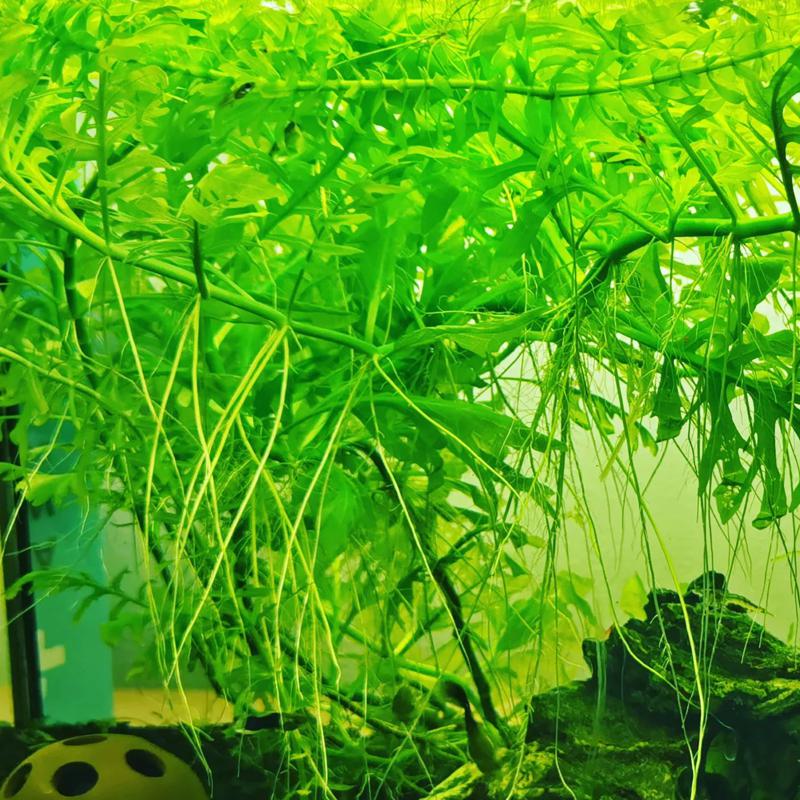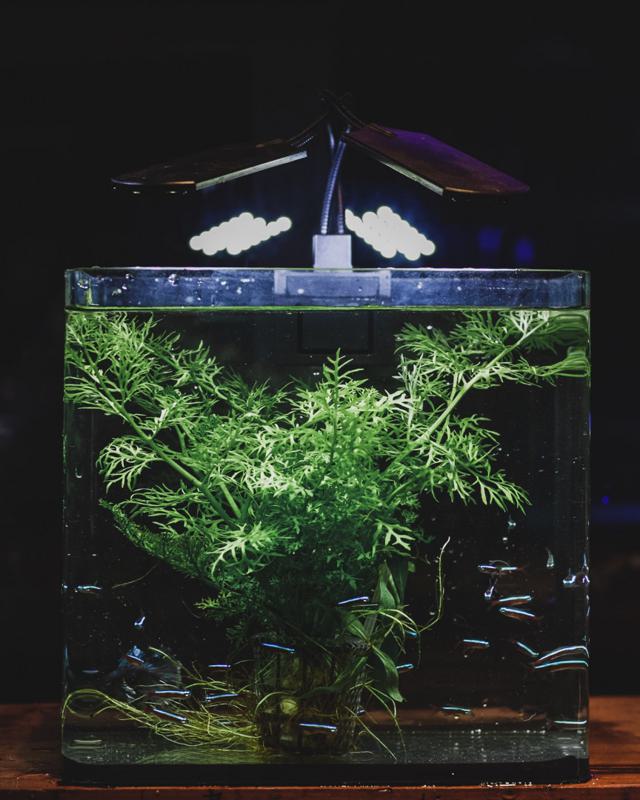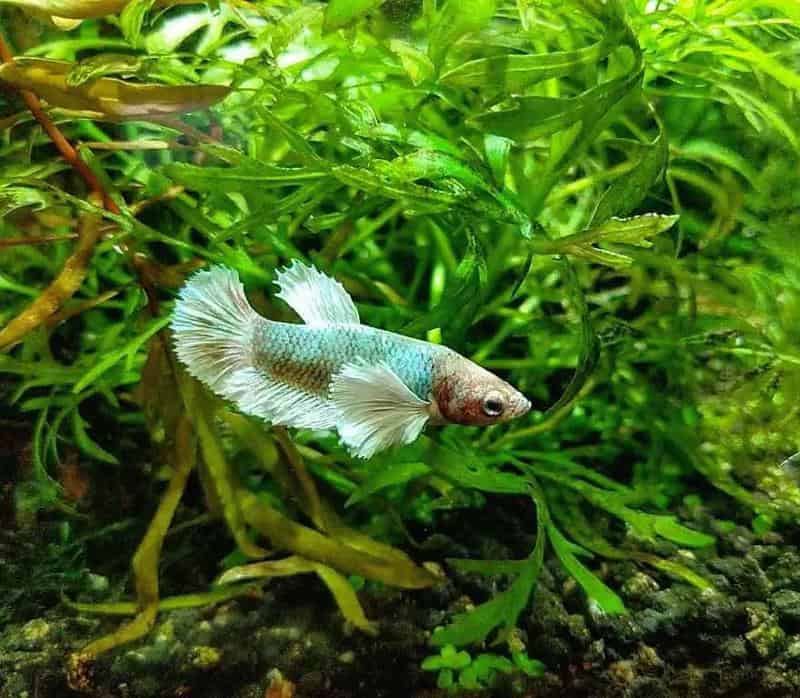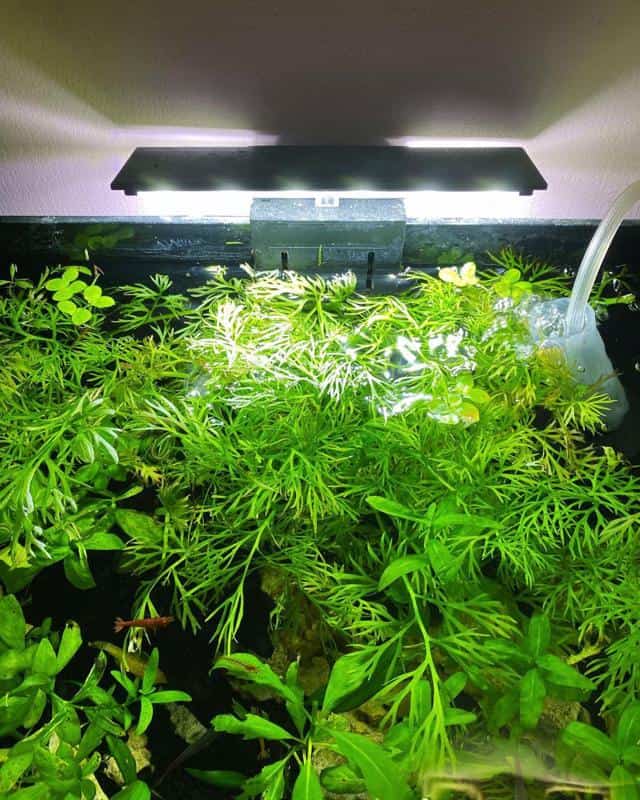In general, plants change their form as they grow. From a tiny seedling, they grow into their adult form (either a tree, vine or shrub).
However, this is seldom observed in aquarium plants, especially that their enclosed living conditions restrict them from growing to their full potential.
Well, not for the Water Wisteria. The fact is that the conditions restricting the growth in other aquarium plants is the main ingredient that shifts Water Wisteria into other shapes.
Intriguing, right?
In this article, you will learn why Water Wisteria changes form, the factors that affect their shape-shifting traits and how to optimally grow them.
Water Wisteria Characteristics

Heterophyllus Leaves
Water Wisteria (Hygrophila difformis) is a green-colored and vertical-growing plant with stems that branches out in every direction, creating a bushy appearance. However, do not be surprised if their physical look changes over time.
Like other heterophyllus species, they produce leaves with different thicknesses and shapes. But with Water Wisteria, this trait is influenced by the water condition to which the plant is exposed.
Although water temperature and nutrient level may influence, light intensity greatly affects the degree of leaf variation in Water Wisteria.
When your Water Wisteria is exposed to low-light conditions, it will produce lacy-looking leaves that are thin, elongated, and divided into several segments. But when exposed to bright light, they shoot out thick leaves that are broad and oval-shaped.
Speedy-Growing Column Feeders
Rooting a plant in the substrate will give you an initial impression that it is a root feeder. But in the case of Water Wisteria, even if they are rooted at the bottom, they are column feeders.
When they grow, Water Wisteria absorbs nutrients directly from the water. The fact is they are so efficient in absorbing organic compounds that they prevent algae growth and many aquarists have considered them natural water filters.
In effect to consuming more nutrients, Water Wisteria will grow fast. When conditions are conducive for growth, they can grow as fast as 2 to 3 inches per week and may reach a maximum height of 24 inches.
South Asian Origins
Originating from the eastern section of South Asia, Water Wisteria are naturally thriving in the freshwater environments of Bangladesh, Bhutan, India, and Nepal. It naturally thrives in streams, marshes, ponds, lakes, and riverbanks with low water flow.
Wild Water Wisteria is highly adaptable, especially to the fluctuation of water level. During the rainy season or the water level is high, it grows as a submerged plant sprouting leaves that are thin and feathery.
On the other hand, Water Wisteria can partly or totally grow out of the water during the dry season and the leaves they produce by this time are broad and thick with the blossoming of small blue-violet flowers.
Potentially Invasive
With its adaptability and fast-growing traits, Water Wisteria can become an invasive species and has disrupted the freshwater ecosystems of Hungary, Taiwan, and the United Kingdom.
What happens when they are accidentally or intentionally introduced to a foreign body of water, they will grow fast and outcompete native aquatic plants. In effect, they lower the biodiversity of an area, and worst, may clog the flow of local waterways.
Unrelated to Flowering Wisteria Plant
Water Wisteria was named for its resemblance to the terrestrial Wisteria plant (Wisteria sp.). However, in terms of taxonomy and origins, both plants are totally different from each other.
While Water Wisteria is classified as a submerged and emergent herb under Family Acanthaceae, the Wisteria plant is a legume belonging to Family Fabaceae.
Further, while the origins of Water Wisteria can be traced back to South Asia, the Wisteria plant are East Asian natives and abundantly thrives in China, Japan, and Korea.
Water Wisteria vs Water Sprite

Being in demand, Water Wisteria and Water Sprite are commonly available in pet and aquarium shops. However, with their similarity in their names, they are often misidentified and interchanged, especially for newbies. It should not be the case since the main difference between these two plants is their physical appearance.
When growing, you will see that Water Wisteria shoots from a clearly defined root system, while the entire plant of a Water Sprite grows from a central point.
For the leaves, Water Wisteria displays a variety of leaf shapes, while the leaves of a Water Sprite are long and pointed during its entire life. And lastly, Water Wisteria produces flowers, while Water Sprite is flowerless since it is a fern.
Quick Summary: Difference between Water Wisteria and Water Sprite
| Water Wisteria | Water Sprite |
| Grows from a defined root | Grows from a central point |
| Has flowers | Flowerless |
| Leaf shape variation | Constant leaf shape |
Growth Requirements of Water Wisteria
Water Wisteria is a highly adaptive and hardy plant and can thrive in a range of water conditions. However, they have preferred parameters for them to grow optimally.
10-gallon Aquarium
Under optimal conditions, Water Wisteria will grow into a tall and bushy plant. Placing them in a small tank will result in stunted growth and overcrowding. With this, using a 10-gallon tank or bigger is recommended.
Tropical and Neutral Waters
Water Wisteria prefers a pH ranging from 6.5 to 7.5 and neutral waters are advantageous to them since it can hold the ideal amount of nutrients (like potassium, nitrogen, and phosphorus) for plant growth.
Being native to Asia, Water Wisteria prefers tropical warm waters ranging from 22 to 28 C (72 to 82 F). Aside from mimicking their natural condition, warm waters help Water Wisteria in their enzymatic reaction that efficiently converts the nutrients they have absorbed into energy.
12-hours Moderate Light Exposure
Water Wisteria can thrive in any lighting intensity. If you want them to have lacy-looking leaves, then you can expose them to low light. On the other hand, if you want your plant to have broad and thick leaves, then you should expose them to bright light.
What most aquarists favor is for their Water Wisteria to have both leaf shapes. To do so, use moderate lighting and expose them anywhere from 10 to 12 hours daily.
Hard Gravel Substrate
Water Wisteria needs a hard substrate (like gravel) to support its bushy growth. While you can still use sand, it is not recommended since the plant’s roots may not hold itself firmly.
Using gravel as their substrate allows their roots to have a strong grip and will support the plant without being uprooted even with the occasional swaying.
Low to Moderate Water Flow
Strong water flow is an enemy of Water Wisteria. It damages their stems, leaves and may potentially uproot the plants if their roots are still underdeveloped.
To mimic its wild habitat, low to moderate water flow is ideal for Water Wisteria. In this way, the nutrients are evenly distributed in the tank, and allows other plants their share of nutrition.
Nutrient Supplementation
The organic substances from fish waste is sufficient enough to support the nutrient requirement for your Water Wisteria, but that’s if there’s no other plants in the tank.
In most cases, since Water Wisteria is rooted along with other aquarium plants, then they need nutrient supplements.
Being a column feeder, you can give them liquid fertilizers rich in potassium, iron, nitrogen, and phosphorus. Carbon dioxide (liquid or injection) is also beneficial for your Water Wisteria since it enhances their growth.
Summary of the growth requirement of Water Wisteria
| Parameters | Range |
| Substrate | Gravel |
| Light | Low to High (but ideally moderate) |
| Water flow | Low to Moderate |
| Temperature | 22 – 28 C (72 to 82 F) |
| pH | 6.5 – 7.5 |
| Hardness | 2 – 15 |
| Fertilizers | Low to Medium |
| CO2 | Low to Medium |
Water Wisteria Planting Procedure

Being a versatile plant, Water Wisteria can either be rooted in the substrate or become a floating plant. But it doesn’t mean you just place them at the surface or stake them at the substrate. Planting them needs preparation, as follows:
Pre-Planting Preparations
Regardless of where you purchase or sourced out your Water Wisteria, make sure you only use healthy plants. Remove any unhealthy or withered leaves and trim down their roots if they are excessively long.
Planting Options
The good thing with Water Wisteria that adds up to its adaptability and versatility is their variety of plating options, such as:
Floating
Water Wisteria can be placed at the upper level of your tank and become floating plants. All you need to do is place a few shoots at the surface and allow them to thrive peacefully.
Overtime, you will see them growing dangling roots and some of their leaves may grow out of the water. Similarly, during their blooming season, your Water Wisteria may produce flowers, but that’s only if you don’t have a lid or have enough aerial space.
Rooted
The most common way to plant Water Wisteria (which is often seen in most setups) are them being rooted in the substrate. You can do this by burying them in the substrate at least 2 inches deep.
Prior digging is not required. All you need to do is gently drive in the plant in the substrate and allow the gravel to naturally hold the plant.
Potted
Potted Water Wisteria is seldom seen, but it can be done and most do it for easy handling. With your chosen pot, place in the bottom part of the plant and add gravel for support.
Overtime, you will see roots shooting out of the pot. When you choose to relocate your Water Wisteria, you don’t need to uproot them. Just take the planted pot to the spot you want it to be.
Water Wisteria Pruning Procedure

Not unless you want your tank to be unruly and overcrowded, then pruning your Water Wisteria is required. From their vertical growth, decide how tall or short you want your Water Wisteria to be.
Once you determine your desired height, you can start trimming them using aquarium scissors. But don’t just cut any part of the plant. We recommend you cut in between shoots where the leaves sprout. In this way, you allow new branches to sprout without damaging the stems and leaves.
Dispose the trimmings properly and do not throw them directly in local waterways as they can become invasive. Similarly, you can use the trimmings for replanting or use them for propagating your new batch of Water Wisteria.
Methods of Propagation
While Water Wisteria can reproduce sexually, it rarely happens in a tank setup. Commonly, their mode of propagation is asexual through vegetative propagation.
Using the trimmings, you can prepare them to become your plantings. Just like in the pre-planting procedure, remove any damaged or unhealthy leaves.
After which, you can pot them, directly bury them in the substrate or place them in the surface water to become floating plants.
Also Read:
Water Wisteria: FAQs
What Is the Water Change Requirement of Water Wisteria?
10 to 20% weekly. In this way, you are partly adding new water while removing the accumulated waste in the tank.
Why Is My Water Wisteria Turning Yellow?
If your Water Wisteria is not getting enough nutrients, its leaves will start to wither and become yellow. Make sure to give them nutrient supplements that are rich in potassium, iron, nitrogen, and phosphate.
Further, be mindful to read the label of your nutrient supplement and look out for any copper content. If there is, do not use it with your Water Wisteria as they are sensitive to this type of nutrient.
Final Thoughts
Due to the versatility of Water Wisteria, they have become highly popular amongst aquarists. Many of us have used them to enhance the aesthetic beauty of our tank and turn our once bare-dull tank into a vibrant greenery in less time.
In my setup, I rooted some Water Wisteria at the center with some plants floating on the side. And guess what, I was able to create not just an Asian-inspired aesthetic, but an Amazon-theme tank in less than a month. Try it and enjoy!